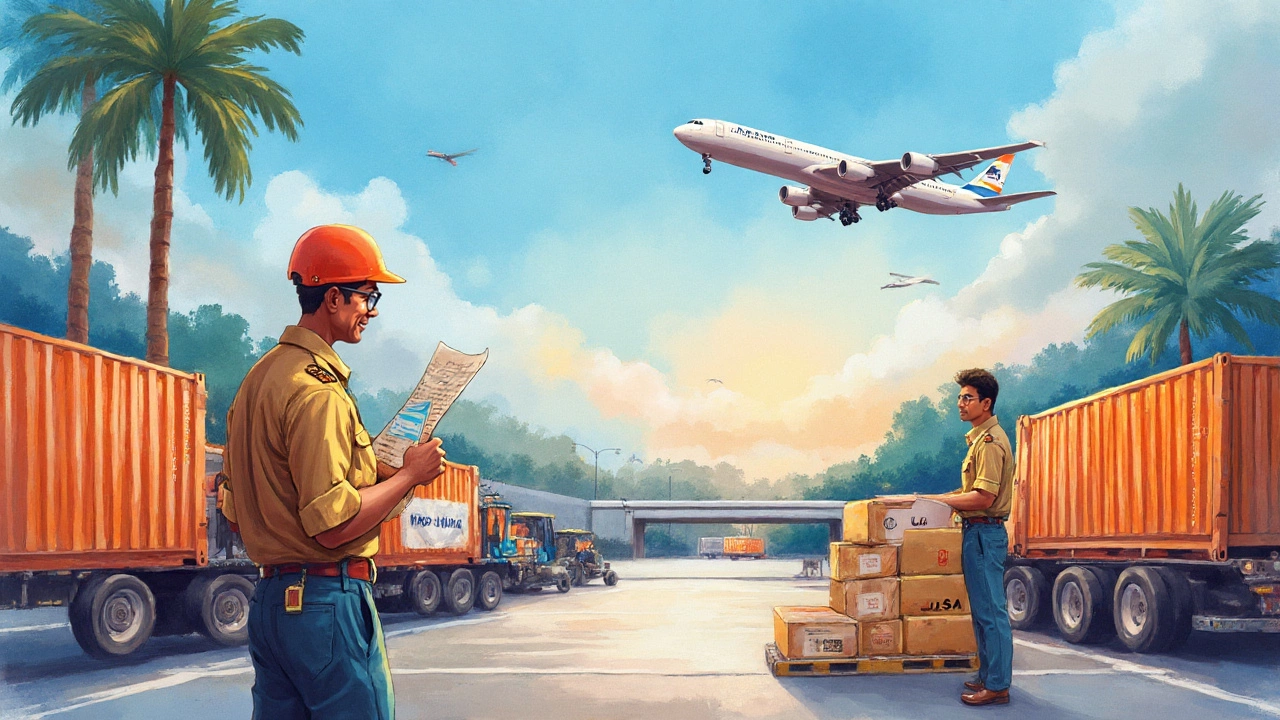Think it’s impossible to ship your handmade jewellery from Jaipur all the way to a customer in New York? You’d be surprised how many first-timers in India pull it off—with the right roadmap and some street smarts. Selling products from India to the USA isn’t just for giant corporations. The rules might look intimidating at first, but thousands of homepreneurs and small brands go international from their bedroom or backyard shop every year. American buyers have a wild appetite for everything from Indian spices, skincare, yoga gear to engineering parts and textiles. And digital tools let you reach those buyers faster than ever. But before boxing up your bestsellers and queuing at the courier counter, you need to outsmart regulation, get the paperwork perfect, and understand cultural quirks. You don’t want your shipment sitting in a US port like a forgotten suitcase. Here’s exactly what you need to watch out for and why this opportunity might be a lot bigger than your cousin’s drop shipping side hustle.
Understanding the Opportunities for Indian Products in the USA
First, let’s break down why the USA is such a magnet for Indian exporters. The US market is gigantic—over 331 million people, and they spend more on consumer goods than any other country. What’s cool is Americans are always keen for something new or exotic. If your product’s got a story or an authentic vibe, it’ll probably find its tribe. Indian spices, teas, and ayurvedic products practically have cult followings (just check the natural food shelves in a Whole Foods). Indian-made apparel and juttis have been popping up everywhere in LA and New York, and Indian jewellery giants like Tanishq are opening stores in American suburbs.
The numbers back it up: Indian exports to the USA crossed $77 billion in 2023, according to India’s Ministry of Commerce. And not just “standard” stuff—everything from dry-roasted makhana snacks to vegan leather bags and even customized modular kitchens fly off e-commerce shelves. If you hit the right niche with a great story and good pricing, getting repeat American customers isn’t far-fetched at all.
Ecommerce has made things even more open. Earlier, you needed contacts, catalogs, and a lot of cold-calling. Now, with platforms like Etsy, Amazon, Shopify, and eBay, alongside logistics partners (think DHL, FedEx, or even India Post’s EMS for smaller orders), you can list, ship, and market almost overnight. Amazon Global Selling, for example, helps Indian brands reach millions of US shoppers. Shopify lets you set up your own store that accepts US dollars and integrates with payment gateways like Stripe or PayPal. Even Indian startups, such as Chumbak and Vahdam Teas, use these tools to win over American buyers.
But opportunity doesn’t mean it’s a walk in the park. The US customer expects speed, honesty, no-nonsense refunds, and quality. Competition is tough. And crossing the border brings along red tape you can’t ignore. So the gap between “I have a cool product” and “Americans are unboxing my packages” is real, but with smart steps, it’s totally bridgeable.
Export Rules, Documents, and Compliance: What You Need
This is where a lot of would-be exporters stumble—paperwork, laws, and compliance requirements. Selling your product from India to the USA isn’t as simple as dropping it in the mail. You need to play by Indian export rules and also satisfy US import regulations. First up, you must get an Importer Exporter Code (IEC) from India’s DGFT (Directorate General of Foreign Trade). Without an IEC, Indian Customs will not let your shipment leave the country. Apply online—process is quick and barely takes a day if you’ve got your documents ready (PAN card, proof of address, etc).
After you’re legit on the Indian side, it’s time to check the US rulebook. The US Customs and Border Protection (CBP) watches every incoming item. All imports need a Bill of Lading or Airway Bill, an invoice in English, a proper packing list, and, for many products, a Certificate of Origin. You’ll also need to clearly describe the product, its HS (Harmonized System) code, and value. If you’re dealing with food, skincare, or anything touching human skin (think herbal balms or turmeric face packs), you need to register with the US Food and Drug Administration (FDA)—no exceptions. They’re very strict about health violations.
For textiles, you might need to comply with the US Federal Trade Commission’s labelling laws—it sounds picky, but even a tiny mistake on a label can mean a returned shipment or worse, a fine. For electronics and certain machinery, certifications like FCC (Federal Communications Commission) compliance are mandatory. Wooden items? The US Department of Agriculture (USDA) needs proof your products are free from pests, especially for things like handcrafted furniture or decorative crafts made from raw or unfinished wood.
Tackling taxes is another part most new exporters overlook. The US has something called an Import Duty—this is a fee based on product category and declared value. While many Indian products enjoy reduced duty rates under trade agreements, it always pays to double-check the Harmonized Tariff Schedule or use the USITC’s free lookup tool online.
If you’re selling through platforms like Amazon, Etsy, or Shopify, there will also be platform-specific compliance issues. For example, Amazon needs your product barcoded, labelled to their specs, and registered on their backend system before entering their fulfilment centres (FBA). Miss these details, and your stock gets stuck or delisted.

Setting Up Shipping and Logistics from India to the USA
Getting your products to those US customers quickly and safely means you need a solid game plan for shipping and logistics. Small exporters usually start with international courier services—DHL, FedEx, Blue Dart, India Post EMS. These are fast and take care of custom clearance on both ends. But watch the fees—shipping just a few kilos with premium couriers can eat up your profits quickly. India Post’s EMS is a cheaper option for smaller parcels, and surprisingly reliable for under-2kg shipments.
Bigger shipments, or rising demand, calls for working with Freight Forwarders. They handle bulk cargo, sea shipping (which is slower but cheaper than air), and can connect you to customs brokers in the USA who’ll help navigate import regulations. Shipping by sea takes anywhere from 20 to 45 days door-to-door, depending on the port. Popular US ports for Indian goods include New York, Los Angeles, and Houston. Many Indian logistic companies partner with US brokers to offer “end-to-end delivery” and can even store your items in US-based warehouses for faster last-mile delivery once orders come in.
Packing matters more than you’d guess. US customs hates shoddy, mislabelled, or leaking packages. Don’t use straw, shredded paper, or natural packing that might carry seeds or bugs—it could get your parcel quarantined. Most importers prefer double-boxing and vacuum-sealed packs for food. For infrequent shippers, shipping software like Shiprocket and Easyship let you compare courier prices and track international parcels in real time.
Insurance for high-value items isn’t a luxury. Packages sometimes get lost or damaged in transit—it’s rare, but not impossible. Most international couriers offer nominal insurance for a small fee. Consider it for shipments over Rs 10,000 in value. And always document what you ship—take photos, keep customs paperwork handy—because you’ll need this proof if anything happens.
Market Preferences, Pricing Strategies, and Reaching US Customers
The US market is a weird beast—what sells like hot jalebis in Mumbai flops in Chicago if you don’t tweak your message. American shoppers love the ‘why’ behind the product, not just the product itself. Explaining your product’s Indian roots, benefits, production story, and even sharing pictures of the process hooks buyers way faster than just posting catalogue shots. Many Indian sellers win repeat customers by telling the backstory of their artisans, ingredients, or eco-friendly practice.
Packing and sizes matter a lot. US customers are used to “standard” measurements—ounce, pounds, inches. If you send a 100g spice pack labelled only in grams, they’ll get confused. Always print US-friendly sizes. Clear, professional packaging sells faster and feels more reliable. Avoid spelling errors and weird slogans; American buyers spot unprofessional packaging and often skip repeat orders.
Pricing is tricky. The US customer expects transparency—showing the full price, including shipping and estimated delivery date, helps avoid nasty reviews. It’s smart to include a buffer for import duties and logistics fees in your retail price. For e-commerce, offering free shipping (by baking the cost into the item price) performs better than showing a low price with a big shipping add-on. Competition is fierce—check what similar items on Amazon or Etsy cost and find a sweet spot. You don’t want to go rock-bottom; it cheapens your brand and eats profits.
Getting noticed means hustling across multiple platforms. Here’s a brief rundown where Indian sellers find traction:
- Etsy: Perfect for handmade, vintage, or craft products. The American market on Etsy worships Indian ethnic art and jewelry.
- Amazon.com: Best for reaching a mainstream, big audience. Amazon helps with fulfilment in the US and handles customer support, but their paperwork is very strict.
- Shopify: Lets you run your own store, collect money directly, and control the customer experience. You need to handle marketing and logistics on your own.
- eBay: Renowned for collectibles, antiques, and quirky Indian artifacts. The bidding format sometimes helps in getting higher prices.
Social media ads, especially Instagram and Facebook, work short-term magic when you target the right US demographics. Influencer partnerships, even with small US-based Indian food or lifestyle bloggers, bring credibility. Don’t ignore reviews—American buyers read reviews before buying. If you get good feedback, screenshot and share it. Customer trust builds sales in the US faster than aggressive discounts.

Tips, Real-World Examples, and Secrets for Indian Sellers
Let’s hit some overlooked truths and juicy hacks. Indian spices can’t just be thrown in a bag—asterisk this! The FDA demands clear labelling, even batch codes, and packaging that meets food safety standards. If you sell yoga mats or herbal teas with “wellness” claims, never over-hype or lie—misleading claims get flagged and can even get your listings banned on Amazon. Always be upfront about what your product can and can’t do.
Start with a low-risk test batch. Don’t ship 2000 kurtas at once. Send 10, 20, or 50 items to learn which SKUs stand out, how packages survive shipping, and what feedback US buyers give. You’ll tweak your next batch to dodge return rates and package fails. Many sellers realized Americans actually love “spicier than mild” but hate leaking packets. Fixing that packaging jump-started their repeat sales.
Offer customer support in the US time-zone, if possible. Respond quickly to people asking “Where’s my parcel?” on Etsy or Amazon messages. A polite, fast reply—”Hey, it just cleared customs and should be delivered in 48 hours!”—buys you loyalty and positive reviews. Some Indian sellers use WhatsApp and set up a US WhatsApp number (via apps like TextNow) just for customer communication. A small hack, but makes you look local.
Don’t neglect return policies. In India, returns are rare outside apparel, but American buyers expect easy returns. If you want to avoid pain, clearly explain your return process on every listing and honor reasonable returns fast. Refusing returns is one of the quickest ways to kill your reputation. Consider using US-based return partners (like ShipBob or EasyShip’s US warehouse partners) to accept returns and reship replacements without needing goods shipped all the way back to India—which gets pricey.
Get inspiration from other Indian success stories. Vahdam Teas exploded in the US by blending authentic Indian tea with slick US-friendly branding and packaging. Their secret? Air-freighted, fresh batches every 14 days and direct shipping from their US warehouses to American customers. Other brands like BoAt (electronics) and Suta (sarees) built strong US online followings through relentless Instagram marketing and customer-centric after-sales support.
Finally, networking with Indian diaspora groups in the US opens hidden goldmines. These communities crave authentic Indian products and can help test-market new items fast. Some sellers even do pop-up stalls at US festivals or partner with Indian grocery stores in cities like Edison (NJ) or Fremont (CA) for direct-to-customer trials before launching big online.
Going global feels overwhelming, especially making your first sale in a market as demanding as the US. But with sell products from India to USA as your goal, patience, quick learning, and a willingness to get a little outside your comfort zone is more valuable than a giant marketing budget. Step by step, your Indian brand really can stand out in America—even if your ‘office’ is your spare bedroom.

